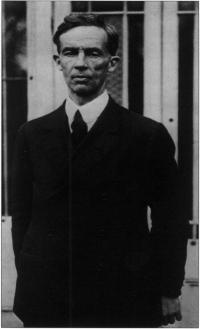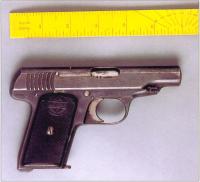Poltergeist Pistol
Published in 20th-century / Contemporary History, Features, Issue 3 (Autumn 1995), Revolutionary Period 1912-23, Volume 3
Erskine Childers (BBC Hulton Picture Library)
On 27 April 1923 de Valera and Aiken published peace proposals to end the civil war: all arms should be under control of the executive government responsible to the people through their elected representatives. They insisted that all arms would have to be surrendered. Nevertheless when Fianna Fáil came back into constitutional politics, albeit as ‘a slightly constitutional party’, its members, ‘minded’ by Vivion de Valera, first entered the Dáil (1927) with revolvers bulging in their pockets. That throws into sharper relief the misfortune of Erskine Childers, executed in 1922 for possession of a tiny ornamental pistol, which, more ironical still, was a present from Collins in happier days. Childers, son of Londoner Professor Robert Childers, was educated at Hailesbury and Trinity College, Cambridge. In July 1914 in his yacht, Asgard he ran 900 rifles and 2,9000 rounds of ammunition into Howth for the Irish Volunteers. He was the darling of all Irish nationalists then and could never have imagined, after all his gun-running hazards, that a toy pistol would trigger his downfall and death by his former Irish comrades.
He had been elected to Dáil Éireann for Wicklow in 1921 and spoke forcibly against in the Treaty debates. Up to that Irishmen of all shades of opinion had liked him. English people as distinct from British governments were generally fairly well liked in Ireland. There had been so much intermingling on both sides of the Irish sea over the centuries that the two peoples had more in common than they realised or sometimes cared to admit. Many saw in Childers the decent Englishman who loved Ireland. Collins gave him a present of little pistol telling him that it was to ‘defend the Republic’. It was a tiny automatic, little better than a toy, and in no sense a war weapon.
Childers demonised
However, after the outbreak of civil war at the end of June 1922, the attitude to Childers changed completely. Though he had never fired a shot the pro-Treaty side ridiculously demonised him, blaming him for every culvert that was blown up. He was singled out for personal attack by Arthur Griffith in the Dáil. The idea of an Englishman poking his nose into Irish affairs maddened them all. Ironically the scornful republican fighting generals also ostracised both Childers and de Valera. Neither of them was given any military standing whatsoever. De Valera was kept in his political box. Childers was confined to non-military duties. The British of course reviled him as a renegade.
On his way back to Dublin to act as secretary to the reconstituted republican government, Childers stayed the night of 10 November 1922 with his cousin, Robert Barton in Annamoe, County Wicklow. In the early morning a small raiding party of Free State troops seized him as he drew his small pistol, the present from Michael Collins. He did not fire it as the ladies present would have been endangered by an exchange of shots. He was always a most chivalrous man. He was charged and tried by military court on 16 November for the offence of possession, without lawful authority, of an automatic pistol. He was sentenced to death and executed by firing squad at Beggars Bush Barracks on the morning of Friday 24 November. It was too dark to proceed at the appointed hour so they had to wait until there was sufficient light. He smoked, chatted and shook hands with the firing party, disclaiming any feeling of ill-will against anyone and died most bravely.

A Similar .32 Spanish automatic.
(Courtesy of D’ Branch(Services), An Garda Siochana)
Life of its own
His pistol however did not regard that as the end of the matter and took on a troublesome restless life of its own. It was included among the exhibits of the proceedings and the Judge Advocate General of the day, Cahir Davitt, hung on to it for his own use intending to return it to Childers’ family in due course. It asserted itself at once and he had several adventurous experiences with it. In early 1923 he took the last taxi home to Collin’s Barracks from a dance in the newly opened Metropole Ballroom. He was stopped by a patrol of Free State troops—the civil war was still on. Davitt was in evening dress and had no means of identification. He declared the pistol and explained who he was. However, the corporal was not prepared to take his word for it and he was lugged to Collins Barracks for identification. The trouble was that among Davitt’s friends there were incurable practical jokers who would deny that they ever knew him, just for the hell of it. They did just that. In the end it took subterfuge to secure his identification. He blamed the poltergeist pistol for his predicament.
His second pistol-related adventure occurred at a dinner party in Judge Johnston’s house in Lansdowne Road and involved another taxi journey—this time to Portobello (now Cathal Brugha) Barracks. He was fiddling with the pistol which was in his great coat pocket. The safety catch must have been off and as they bumped over a level crossing there was a loud bang and he felt a violent blow on the front of his right thigh. The driver thinking someone was taking a pot shot at them accelerated. When paying him Davitt explained what had happened offering to pay for any damage the bullet made in the car. There were no traces of blood and when he got to his quarters he found that there was a mark on the leg of his dress trousers where the bullet had removed the nap of the cloth without cutting or fraying the fabric. He had a bruise on his thigh. He had a lucky escape from the implacable pistol.
Undeterred the unlucky weapon had a third go. In the early thirties Davitt took to constantly carrying this automatic pistol as he had to try a succession of offences against the State cases. One Saturday afternoon he attended the final of the Leinster Senior Schools Cup at Lansdowne Road. The pistol seemed to be at its most mischievous in that area. After the match he adjourned to the members’ bar for a drink. This time he had his hand in the right hand pocket of his light rain coat where the wretched weapon reposed. Once again there was a loud bang which startled his companion. He explained as nonchalantly as he could that it was only a car back firing. In the babble of the Lansdowne bar nobody appeared to take much notice of the shot. Davitt observed a neat hole in the toe cap of his right shoe. He had drilled a hole neatly through his big toe. The bullet had gone through the bone, shattering it. The time had come for Davitt and the pistol to part company. On 4 November 1937, at a lunch on Stephen’s Green, he ceremoniously returned it to Childers son, later President, then Minister for Lands and Fisheries. He was heartily glad to be rid of a weapon which in his hands proved to be more of a danger than a protection.
Where is it now?
When writing A History of the Irish Army, I tried to track down the historic weapon. It was a .32 Spanish Automatic No. 10169. After President Childers’ death his aide-de-camp dutifully handed it in at Cabra Garda Station. It does not seem to have made its way from there to the Garda Museum. That would perhaps be too dull for its restless spirit. Nor is it in the Military Archives. It is hard to see it settling down there either, exciting and all as that researcher-friendly place is. Myles Dungan of RTE spoke to a Spanish arms dealer who had bought job lots of historic Irish weapons as scrap. When I heard that I hoped against hope for a clue. I gave Myles the serial number but I never found out whether he had made contact or not. I feel certain that the pistol is intact somewhere. Its a great pity to lose it in such a philistine way. The Finance Section of the Department of Defence behaved insensitively in flogging those historic weapons to arms dealers for a song. Only fire brigade action by public spirited cavalry officers rescued at the eleventh hour the Michael Collins armoured car Slieve na mBan from the scrap yard. Others and artillery pieces were not so lucky.
The only hope of recovery lies in replies from readers of this article and the poltergeist pistol’s congenital assertiveness. It is bound to be making mischief somewhere!
J.P. Duggan is a former Irish army officer and author of A History of the Irish Army (1991).
















